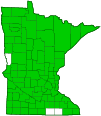American bittersweet
(Celastrus scandens)
Conservation • Wetland • Description • Habitat • Ecology • Use • Distribution • Taxonomy
Description |
||
American bittersweet is a perennial woody vine that rises from a woody taproot. It is usually found climbing on a tree or other adjacent vegetation. It can climb up to 65′. Occasionally it appears as a low shrub or sprawls on the ground. Stems are green and hairless in the first year, becoming gray or brown in the second year. They do not have tendrils or aerial roots. They climb by growing spirally (twining) from left to right (dextrorsely). Older stems eventually become woody and get up 2¾″ in diameter at the base. The branches are circular in cross section and are not winged. The bark on young woody stems is thin and brown. On mature stems the bark is light gray and rough with corky, diamond-shaped ridges. The bark on older stems is smooth and peels off in flakes (exfoliates). The leaves are alternate and deciduous. They are variable in shape, even on the same stem. When they first appear and begin unfolding each side of the blade is rolled inward toward the upper side. Young leaves are yellowish-green and have a long drawn out tip. Mature leaves are on ⅜″ to 1″ long leaf stalks. The leaf blades are elliptic, elliptic egg-shaped, or inversely egg-shaped; 2″ to 4¼″ long; and 1″ to 2⅜″ wide. They are often at least than 2 times as long as wide. They are rounded to angled or short tapered at the base, and usually tapered to a sharp point at the tip with curved sides along the tip. The leaf tip is often ⅝″ long or longer. Sometimes the leaf blades are rounded at the tip. The upper surface is green or dark green and hairless. The lower surface is paler green and hairless. The margins are finely toothed with rounded or incurved teeth. The teeth have small gland at the tip. The leaves turn greenish-yellow to yellow in the fall. The inflorescence is an elongated, ¾″ to 2⅜″ long, branched cluster (panicle) of 5 to 60 flowers at the end of each stem branch. The flowers mature from the bottom up. Male and female flowers are similar and are borne on separate plants. Each flower is about ¼″ across and has 5 sepals and 5 petals. The sepals are green and 1⁄32″ to 1 ⁄16″long. The petals are pale green or greenish white, about ⅛″ long, and 1⁄32″ to 1 ⁄16″wide. Male flowers have 5 stamens and a small, nonfunctioning (vestigial) pistil. The stamens have white filaments the anthers have white pollen. Female flowers have a functioning pistil and 5 vestigial stamens (staminodia). The style is stout and has a 3-lobed stigma at the tip. The fruit is a more or less globe-shaped, ¼″ to ½″in diameter, 3-lobed capsule. The capsule is green at first, turning bright orange at maturity. It matures in early September to early October. At that time the it splits open into three parts and folds back revealing 3 to 6 bright red, berry-like seed coatings (arils). Each aril contains a single brown seed. The fruits remain on the vine through the winter. They are poisonous to humans but not to birds. |
||
Height |
||
Climbing, up to 65′ in length |
||
Flower Color |
||
Pale green or greenish white |
||
Similar Species |
||
| Oriental bittersweet (Celastrus orbiculatus) bark is dark brown and does not exfoliate. When leaves first appear and begin unfolding the blade is folded in half along the midvein, not rolled inward. Mature leaves are broader, inversely egg-shaped to almost circular, and mostly less than 1.4 times as long as wide. The leaf tip is usually ⅛″ long or less. The inflorescence is a small cluster of 2 to 7 flowers rising from the leaf axils and at the end of the stem. The pollen on male flowers is yellow. The fruit capsule is yellow at maturity. | ||
Habitat |
||
Moist to dry. Thickets, upland woodlands, woodland edges and openings, and roadsides. Partial shade. |
||
Ecology |
||
Flowering |
||
Mid-May to late June |
||
Pests and Diseases |
||
|
||
Use |
||
|
||
Distribution |
||||
|
Sources |
|||
| 3/14/2022 | ||||
Nativity |
||||
Native |
||||
Occurrence |
||||
Widespread and fairly common |
||||
Taxonomy |
|||
| Kingdom | Plantae (Plants) | ||
| Division | Tracheophyta (Vascular Plants) | ||
| Subdivision | Spermatophytina (Seed Plants) | ||
| Class | Magnoliopsida (Dicots) | ||
Order |
Celastrales (staff-vines and allies) | ||
Family |
Celastraceae (bittersweet) | ||
| Subfamily | Celastroideae | ||
Genus |
Celastrus (bittersweet) | ||
Subordinate Taxa |
|||
|
|||
Synonyms |
|||
|
|||
Common Names |
|||
American bittersweet climbing bittersweet staffvine waxwork |
|||
Glossary
Aril
A fleshy, berry-like covering of the seed coat, as with Canada yew.
Axil
The upper angle where a branch, stem, leaf stalk, or vein diverges.
Dextrorse
Turning to the right, as in some twining vines, or arranged spirally from left to right, as in leaf arrangement on a stem.
Exfoliate
Peel off in flakes or layers, as with the bark of some trees.
Filament
On plants: The thread-like stalk of a stamen which supports the anther. On Lepidoptera: One of a pair of long, thin, fleshy extensions extending from the thorax, and sometimes also from the abdomen, of a caterpillar.
Panicle
A pyramidal inflorescence with a main stem and branches. Flowers on the lower, longer branches mature earlier than those on the shorter, upper ones.
Sepal
An outer floral leaf, usually green but sometimes colored, at the base of a flower.
Staminode
A modified stamen that produces no pollen. It often has no anther. Plural: staminodia.
Twining
Growing in a spiral usually around a stem of another plant that serves as support.
Vestigial
An organ or part that is much reduced in size, imperfectly formed, and nonfunctional, that may have been larger, perfectly formed, and functional at one time.
Wing
A thin, flat, membranous, usually transparent appendage on the margin of a structure.
Visitor Photos |
|||||
Share your photo of this plant. |
|||||
| This button not working for you? Simply email us at info@MinnesotaSeasons.com. Attach one or more photos and, if you like, a caption. |
|||||
Kirk Nelson |
|||||
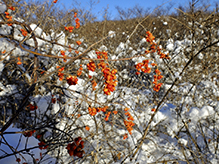 |
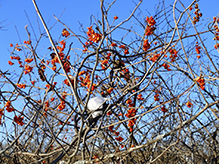 |
||||
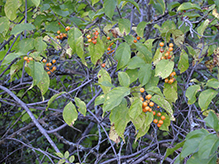 |
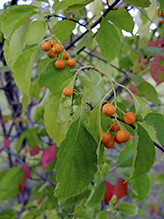 |
||||
MinnesotaSeasons.com Photos |
|||||
Vine |
|||||
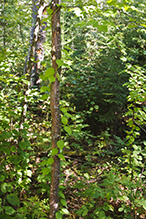 |
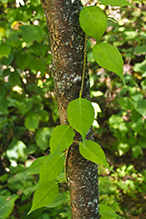 |
||||
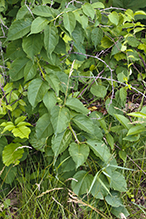 |
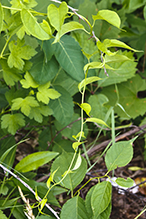 |
||||
Leaves |
|||||
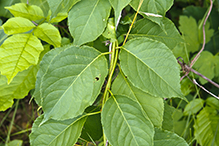 |
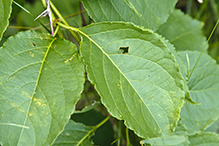 |
||||

Slideshows |
||

Visitor Videos |
|||
Share your video of this plant. |
|||
| This button not working for you? Simply email us at info@MinnesotaSeasons.com. Attach a video, a YouTube link, or a cloud storage link. |
|||
Other Videos |
|||
| Climbing Bittersweet discovery heynsenene's channel |
|||
About
Uploaded on Jan 25, 2012 Saw the berrys on the forest floor, jogged my memory, located it in my book, checked the web on the smartphone, and then shared it with you!! DON'T EAT THE BERRYS PEOPLE! |
|||
| American Bittersweet OKGardeningClassics |
|||
About
Published on Jul 21, 2014 11/07/98-Host Brenda Sanders educates viewers about the American Bittersweet. |
|||
| Bittersweet ID & Damage for Crafters University of Minnesota Extension |
|||
About
Published on Nov 26, 2013 University of Minnesota Extension forester Angie Gupta explains the differences between American bittersweet and Oriental bittersweet, and why crafters should take care to avoid using the invasive species Oriental bittersweet in wreaths and other crafts. Visit http://z.umn.edu/orientalbittersweet for more information. Photos are courtesy of the Minnesota Department of Agriculture. Copyright 2013 by the Regents of the University of Minnesota |
|||

Visitor Sightings |
|||||
Report a sighting of this plant. |
|||||
| This button not working for you? Simply email us at info@MinnesotaSeasons.com. Be sure to include a location. |
|||||
| Kirk Nelson 12/11/2021 |
Location: Grey Cloud Dunes SNA |
 |
|||
| Kirk Nelson 9/14/2014 |
Location: Crow-Hassan Park Reserve, Hennepin County |
 |
|||
MinnesotaSeasons.com Sightings |
|||||

|
Created: Last Updated: © MinnesotaSeasons.com. All rights reserved. |
